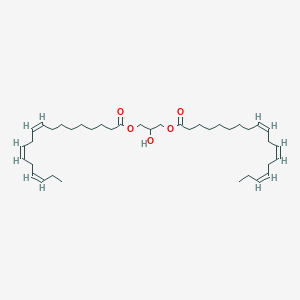| General Information of MET (ID: META00700) |
| Name |
DG(18:3n3/0:0/18:3n3)
|
| Synonyms |
Click to Show/Hide Synonyms of This Metabolite
1,3-Di-(9Z,12Z,15Z)-octadecatrienoylglycerol; 1-(9Z,12Z,15Z-Octadeatrienoyl)-3-(9Z,12Z,15Z-octadeatrienoyl)-sn-glycerol; 1-a-Linolenoyl-3-a-linolenoyl-sn-glycerol; 1.3-Dilinolenin; DAG(18:3/0:0/18:3); DAG(18:3N3/0:0/18:3N3); DAG(18:3W3/0:0/18:3W3); DAG(36:6); DG(18:3/0:0/18:3); DG(18:3W3/0:0/18:3W3); DG(18:3n3/0:0/18:3n3); DG(36:6); DG[18:3(Omega-3)/0:0/18:3(omega-3)]; Diacylglycerol; Diacylglycerol(18:3/0:0/18:3); Diacylglycerol(18:3W3/0:0/18:3W3); Diacylglycerol(18:3n3/0:0/18:3n3); Diacylglycerol(36:6); Diglyceride; Glyceryl 1,3-dilinoleneate; Glyceryl 1,3-dilinoleneic acid
|
| Source |
Aliphatic acyclic compounds
|
| Structure Type |
Lineolic acids and derivatives (Click to Show/Hide the Complete Structure Type Hierarchy)
Lipids and lipid-like molecules
Fatty Acyls
Lineolic acids and derivatives
|
| PubChem CID |
|
| HMDB ID |
|
| Formula |
C39H64O5
|
| Structure |
<iframe style="width: 300px; height: 300px;" frameborder="0" src="https://embed.molview.org/v1/?mode=balls&cid=45934043"></iframe>
|
 |
|
3D MOL is unavailable
|
2D MOL
|
|
Click to Show/Hide the Molecular/Functional Data (External Links/Property/Function) of This Metabolite
|
| ChEBI ID |
|
| Physicochemical Properties |
Molecular Weight |
612.9 |
Topological Polar Surface Area |
72.8 |
| XlogP |
11.6 |
Complexity |
766 |
| Heavy Atom Count |
44 |
Rotatable Bond Count |
32 |
| Hydrogen Bond Donor Count |
1 |
Hydrogen Bond Acceptor Count |
5 |
| Function |
DG(18:3n3/0:0/18:3n3) is a diglyceride, or a diacylglycerol (DAG). It is a glyceride consisting of two fatty acid chains covalently bonded to a glycerol molecule through ester linkages. Diacylglycerols can have many different combinations of fatty acids attached at the C-1 C-2, or C-3 positions. DG(18:3n3/0:0/18:3n3), in particular, consists of two chains of a-linolenic acid at the C-1 and C-3 positions. The a-linolenic acid moieties are derived from seed oils, especially canola and soybean oil. Mono- and diacylglycerols are common food additives used to blend together certain ingredients, such as oil and water, which would not otherwise blend well. Dacylglycerols are often found in bakery products, beverages, ice cream, chewing gum, shortening, whipped toppings, margarine, and confections.<br />Synthesis of diacylglycerol begins with glycerol-3-phosphate, which is derived primarily from dihydroxyacetone phosphate, a product of glycolysis (usually in the cytoplasm of liver or adipose tissue cells). Glycerol-3-phosphate is first acylated with acyl-coenzyme A (acyl-CoA) to form lysophosphatidic acid, which is then acylated with another molecule of acyl-CoA to yield phosphatidic acid. Phosphatidic acid is then de-phosphorylated to form diacylglycerol.<br />Diacylglycerols are precursors to triacylglycerols (triglyceride), which are formed by the addition of a third fatty acid to the diacylglycerol under the catalysis of diglyceride acyltransferase. Since diacylglycerols are synthesized via phosphatidic acid, they will usually contain a saturated fatty acid at the C-1 position on the glycerol moiety and an unsaturated fatty acid at the C-3 position.
|
|
Regulatory Network
|
|
|
|
|
|
|
|
|
 click to show the details of this protein
click to show the details of this protein
 click to show the details of experiment for validating this pair
click to show the details of experiment for validating this pair

